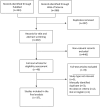Candida auris-a systematic review to inform the world health organization fungal priority pathogens list
- PMID: 38935900
- PMCID: PMC11210622
- DOI: 10.1093/mmy/myae042
Candida auris-a systematic review to inform the world health organization fungal priority pathogens list
Abstract
The World Health Organization (WHO) in 2022 developed a fungal priority pathogen list. Candida auris was ultimately ranked as a critical priority pathogen. PubMed and Web of Science were used to find studies published from 1 January 2011 to 18 February 2021, reporting on predefined criteria including: mortality, morbidity (i.e., hospitalization and disability), drug resistance, preventability, yearly incidence, and distribution/emergence. Thirty-seven studies were included in the final analysis. The overall and 30-day mortality rates associated with C. auris candidaemia ranged from 29% to 62% and 23% to 67%, respectively. The median length of hospital stay was 46-68 days, ranging up to 140 days. Late-onset complications of C. auris candidaemia included metastatic septic complications. Resistance rates to fluconazole were as high as 87%-100%. Susceptibility to isavuconazole, itraconazole, and posaconazole varied with MIC90 values of 0.06-1.0 mg/l. Resistance rates to voriconazole ranged widely from 28% to 98%. Resistance rates ranged between 8% and 35% for amphotericin B and 0%-8% for echinocandins. Over the last ten years, outbreaks due to C. auris have been reported in in all WHO regions. Given the outbreak potential of C. auris, the emergence and spread of MDR strains, and the challenges associated with its identification, and eradication of its environmental sources in healthcare settings, prevention and control measures based on the identified risk factors should be evaluated for their effectiveness and feasibility. Global surveillance studies could better inform the incidence rates and distribution patterns to evaluate the global burden of C. auris infections.
Keywords: Candida auris; drug resistance; epidemiology; mortality; prevention.
© The Author(s) 2024. Published by Oxford University Press on behalf of The International Society for Human and Animal Mycology.
Conflict of interest statement
The authors have no conflicts of interest to declare.
Figures
References
-
- Orgainzation' TWH . WHO fungal priority pathogens list to guide research, development and public health action. Date accessed May 26, 2022. https://www.who.int/publications/i/item/9789240060241.
Publication types
MeSH terms
Substances
Grants and funding
LinkOut - more resources
Full Text Sources
Medical


